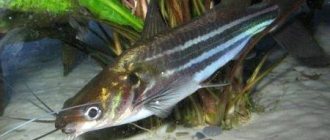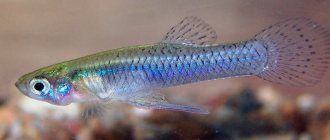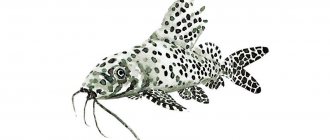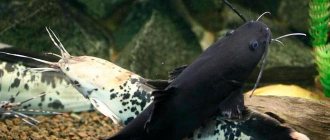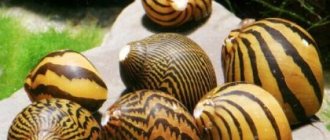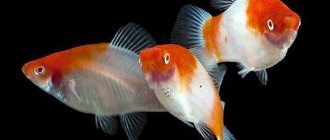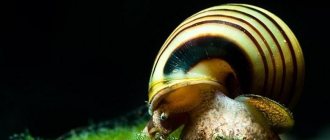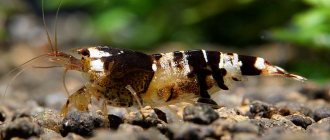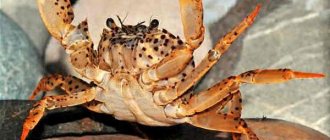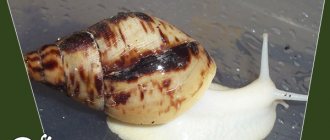There is an interesting feature - the number of stripes on the body depends on the age of the fish, like the annual rings of trees. Young fish have only 5 stripes, by the first year of life the first is divided into two more, and by the age of 3 years there are already 9 black stripes.
Requirements and conditions:
- Aquarium volume - from 200 liters.
- Temperature - 22-28°C
- pH value – 5.5 – 7.5
- Water hardness - from very soft to hard (2-20dH)
- Substrate type - sand
- Lighting - moderate
- Brackish water - no
- Water movement is strong
Fish parameters:
- Size - up to 20 cm.
- Food - plant based
- Life expectancy - from 7 to 10 years
Maintenance and care
An important condition is to maintain high water quality; for these purposes, it is advisable to purchase more expensive canister filters and additional sprayers for effective aeration. Once every two weeks, part of the water (25 - 50%) should be replaced with fresh water. It is recommended to ensure sufficient water movement in the aquarium, simulating the flow of a river. As a rule, canister filters are able to create the desired effect; otherwise, special collectors should be used. When decorating, give preference to objects made of wood (driftwood, roots, etc.) in addition to the decorative effect, they will become an excellent basis for the growth of unicellular algae - an additional source of food. The ground is sandy with several large smooth stones. Do not use fragile design elements; fish are very mobile and can destroy all your elegant designs. Also, be careful when choosing plants, remember that fish can seriously damage soft leaves and stems.
Habitat
The fish was discovered back in the late 18th century in the river systems of Central and South America, and is also widespread in the Amazon basin. They live in fast-moving rivers. During the rainy season, they move to flooded forest areas. When the water recedes, fish often remain in ponds and creeks. They feed mainly on algae, plant debris, worms, insects, and sometimes small fish.
Diseases
Fish of this family, due to their physiological characteristics, have a predisposition to infection with skin parasites, however, under favorable conditions this rarely occurs, but changes in water quality will almost certainly lead to similar results. Read more about symptoms and treatment methods in the section “Diseases of aquarium fish”.
Peculiarities
- A very mobile species, capable of destroying fragile elements of the aquarium design
- Tends to eat plants
- Shows aggression when kept in small groups
- May cause injury to fish with long fins or whiskers
Description
In nature, this is a large fish, reaching a length of 30 cm, in an aquarium it is smaller - 15-18 cm, rarely growing up to 20 cm in length. The body color of the Ribbon (striped) leporine is silvery-yellow. 9-11 dark brown stripes extend along the entire body to the caudal fin. The fins are large, well developed - transparent, often with a grayish tint. The female is fuller than the male. In color it differs from him with an orange throat. The red snout and eyes stand out against the general background of the fish’s body. At night, the body color changes to brown with subtle cream markings. When frightened or, conversely, during a peaceful sleep, a brown lattice appears on the fish’s body.
Zebra fish
Zebra fish is a marine fish up to 30 cm in size, distinguished by the bizarre shape of its body and fins. The head is large, the eyes are set high, the pectoral fins are enlarged and fan-shaped. The dorsal and pectoral fins are equipped with spines, to which the excretory ducts of the poisonous glands approach. The poison is dangerous for humans. The color is white with vertical red stripes of different widths; resembles the coloration of a zebra, which is how this striped fish got its name.
Zebra fish are kept at a temperature of 25-26°C and pH 8-8.4. The content of nitrogen compounds should tend to 0. Fish lead a sedentary lifestyle; feed on fish, shrimp and shellfish.
Features of catfish spawning
According to its biological behavior, the synodontis cuckoo catfish is a nest parasite, therefore it is indifferent to its offspring. If only representatives of this species live in the aquarium, then they most likely will not reproduce successfully.
Therefore, breeders also place other fish with well-developed maternal instincts in the container. Under artificial conditions, synodontis can adapt to the spawning period of almost any fish, but in natural conditions a cichlid usually becomes the “nanny” for its fry.
The cuckoo catfish has a unique biological mechanism that allows it to calculate the beginning of the mating season of these fish and produce small portions of eggs in its body for the so-called adaptation
Cichlid spawning lasts only 1 hour, so it is very important for synodontis to get within this time period
The catfish reaches sexual maturity by the age of two. The reproduction process can be stimulated by creating special conditions:
- In the aquarium, it is necessary to maintain the temperature at 25 °C, hardness - 10 ̊, acidity - pH 7. In the natural environment, the spawning period begins with the beginning of the rainy season; at home, you can simulate this moment by lowering the temperature by 2-3 degrees from normal.
- Change the water frequently - every 2-3 days. Half of the total water volume must be replaced.
Cichlid spawning lasts only 1 hour, so it is very important for synodontis to get within this time period. The cuckoo catfish is one of the few representatives of synodontis that successfully reproduce in captivity
Other species, such as shifter catfish, broadmouth catfish, flag catfish, marbled catfish and veil catfish, cannot produce eggs in a home environment without additional hormonal injections.
Egg laying occurs as follows. Seeing cichlids spawning, female synodontis begin to rush past them, simultaneously throwing eggs. After the process is completed, the cichlid collects its eggs into the oral cavity, but it does not do this very carefully, so grains of sand and other particles, as well as catfish eggs, which are much smaller in size than its own, fall with them. This is how the incubation process begins.
Small catfish hatch a little earlier than cichlids and at first feed on their eggs, so only they remain alive. The cichlids keep the Synodontis fry in their mouth for some time, but they are much larger than their own. In this situation, cichlids practically do not have time to reproduce, so catfish, parasitizing, destroy their offspring. Therefore, in order to preserve the domestic population, it is recommended to periodically place a pair of cichlids before spawning in another aquarium for the safe hatching of their fry.
Star shellfish (Lamprologus stappersi)
It is also called stappersie. These lamprologus are slightly larger than the previous ones: 6 and 5 cm, respectively. Their body is high, elongated and flattened laterally. The muzzle is short, the mouth is located on top, the lower jaw is longer. The eyes are big. There is a bulge at the top of the head.
Both males and females have very impressive body and fin coloring: many white dots are scattered on a brown background.
There are 6 vertical stripes across the body. The sides are purple. The brightness of the color is influenced by the conditions of detention, lighting and decor in the aquarium, as well as the well-being and mood of the fish.
Only a small part of lamprologus is briefly described here, because it is impossible to characterize them all in one article. In general, there are the most beloved and frequently found species in aquariums, which I would like to talk about in more detail.
Aquarium
Capacity from 50 liters, filtration and aeration are required to create a weak flow of water that imitates natural conditions, corydoras live mainly in small streams, ideally they use a substrate of fine sand, although rounded gravel is an acceptable alternative.
Choosing a different decor largely comes down to personal preference; you can add some driftwood and small stones. Live aquarium plants will recreate the natural habitat and will be used by catfish as shelter.
Prefers diffused lighting.
Water parameters:
Temperature: 21 - 27° C pH: 6.0-8.0 Hardness: 7 - 20° dH
Good water quality should be maintained and the soil should be cleaned regularly; any deviation in water parameters leads to a deterioration in the well-being of the fish.
Breeding
The panda barb reaches sexual maturity at the age of 6–9 months. It should be noted that females are low-productive, and besides, males behave extremely aggressively towards their female friends, especially before spawning. For breeding, you must use a small aquarium with a capacity of at least 50 x 50 x 50 cm, where you must place bunches of aquarium plants and a separator net. Such a small aquarium is quite suitable for spawning three pairs of striped barbs and the females will not suffer from quarrelsome males. The temperature in the spawning aquarium should remain within 26°C and have an acidity of no more than 6.5 pH, as well as a hardness of about 10 dH. The incubation period of the eggs lasts 1.5 days, after which the eggs hatch into fry larvae, which have a large yolk sac, which allows them to feed on it for a long time. The transformation of larvae into fry occurs on the 4th day after spawning. At this time, the panda barb fry can already calmly swim around the spawning ground and at the same time they can begin to be fed with cyclops or brine shrimp nauplii. It should be noted that the growth of fry proportionally depends on the amount of live comm in their diet. In order for the fry to adapt to the conditions of the aquarium, settled tap water should be gradually added from the second week after spawning.
Social buttons for Joomla
CUCKOO CATFISH OR SYNODONTIS MULTISPOTTED
Type of synodontis - cuckoo catfish Habitat: Rift lakes (Lake Tanganyika); Content difficulties: easy; Water parameters in the aquarium: t0 23 - 28 C; pH 7.0–8.0; dH up to 20; Life expectancy: up to 10 years; Aquarium size: at least 80L with plenty of hiding places; Body length: up to 15cm; Behavior: peaceful; Diet: omnivorous.
One of the most famous species of synodontis. This beauty comes from Lake Tanganyika in Africa. The fish has a strong, stocky, slightly elongated and laterally flattened body. The head is formed by a lower mouth with 3 pairs of antennae and large eyes. The dorsal fin of Synodontis multispotted is triangular in shape and relatively small in size, and the fat fin is quite large. The back of the fins is colored light blue. The caudal fin is distinguished by highly developed blades, which are decorated with a black edging. Synodontis multispotted has a light yellow color with numerous black spots. Males are distinguished by brighter colors and a higher dorsal fin. It has a peaceful character, but it is not recommended to keep it with small fish. Gets along well with larger fish, African cichlids. Young individuals exhibit a gregarious nature; later they begin to show preference for their own territory. Under natural conditions, the cuckoo catfish feeds exclusively on snails. However, snails are not at all necessary in an aquarium, since the fish get used to high-quality dry food well. This type of fish received its second name because of its spawning method. Synodontis multispotted lays its eggs at the exact moment when another species of fish, such as cichlids, takes its eggs into its mouth for incubation. Catfish eggs are mixed with cichlid eggs and hatched by the other parents. Foundling fry grow together with young cichlids and sometimes feed on them.
SYNODONTIS NIGRIVENTRIS (DAVID, 1936)
Leporinus affinis
Potamon Tauricum (Potamon tauricum) Species range and distribution: Known from the mountain rivers of the Black Sea coast of Turkey, Bulgaria, the Caucasus and the Aegean coast. In Ukraine it is found only in Crimea: mountainous sections of rivers in the south. coast and Belbek river basin. Biotopes: mountainous sections of rivers (ritral) with a flow speed of up to 1 m / and with a predominantly rocky bed. Higher crustaceans play a significant role in the biological processes of water bodies, acting as important elements of food chains. Being sensitive to environmental pollution, many of the higher crayfish serve as excellent bioindicators. The natural habitats of the crab are small rocky areas of mountain rivers with clear, hard and slightly alkaline water. The crab does not go to great depths; it is found in reservoirs at a depth of up to 50 cm. After the rivers of the region descend into the valley, the water becomes cloudy, the bottom is silted, they become unsuitable for the crab to live in, and the crabs crawl out of the water onto the shore. True, potamons are found in Central Asian reservoirs with a high content of hydrogen sulfide, but this is not typical for most of their species. These crabs also avoid high salinity, although they can live in water with a salinity of 0.5%. In suitable biotopes, aggregations of crabs can be observed. In case of danger, they quickly descend into the water, with the movements of their legs they lift a cloud of turbidity from the bottom and hide in it, bury themselves in the ground, under stones. They can settle in artificial concrete irrigation systems and ditches. Potamons hide under stones and in burrows on the shore, often quite long (up to 75 cm in the Crimea and up to 3.2 m in the Caucasus) with a concentration of up to 5 individuals per m2. The hole must lead into water - either into a stream, river or lake, or to groundwater. One burrow is usually occupied by one potamon, less often by a pair.
Crabs are active mainly in the evening and at night, although sometimes they can be found during the day. Compared to crayfish, they are more amphibious - during the night they can move 100 m or further away from the water along wet grass. Females are more active in this regard. With high air humidity, a crab can live without water for 3-4 days, and potamons (with the exception of young ones and females with eggs) generally spend most of their time out of water - in burrows and on stones. Crabs are more active in cool water - at +10 ... +22°C. Unlike crayfish, potamons are very territorial, aggressive and predatory. Especially the males. Fights regularly occur between them for shelter, territory, food, and females. During the breeding season, fights can be especially brutal, sometimes fatal. And when there is a lack of shelter or food, Potamons exhibit cannibalism.
In captivity, mutual killings among crabs are quite common. The strong pursue the weak all the time, trying to damage his eyes, and then kill and eat him. In nature, animals have more living space and have the opportunity to disperse. And juvenile potamons, on the contrary, often stay in groups, accumulating in the water near the shore in thickets of filamentous algae and chara algae. Adult crabs are omnivores; in nature they eat algae, various parts and seeds of aquatic and land plants (Crimean crabs love leaves that have fallen into the water), small worms, amphipods, mollusks, and larvae of aquatic insects. Occasionally they catch insects on land. Caucasian crabs seem to be more predatory than Crimean crabs, which have more plants in their food. But in general, the composition of food changes with the seasons, depending on its abundance. In captivity, crabs prefer animal food, deftly catch grasshoppers and even butterflies, attack frogs and fish up to 6 cm long. Caucasian crabs even attack small turtles! But potamons do not feed on carrion. Once a year, adult crabs molt. At this time, they, like crayfish, hide in shelter. At night, the old shell bursts on the sides and top, and over the course of several hours, with great effort, the crab stretches out its legs, then its abdomen and the front part of its body. During this time, he grows noticeably. After this, it remains motionless and light for several days until the new shell hardens. At this time, the crab does not feed and is completely defenseless against enemies, just like the cancer. Young crabs molt more often. The molting process is regulated by special hormones that are produced in the eyestalks. When the temperature drops to +2 ... +3 °C and below, crabs hide for the winter in holes, under stones and under fallen leaves along the banks, and in these shelters they can withstand frosts down to -20 °C. Wintering lasts 4-5 months. In spring, with water and air temperatures rising to +18 °C and above, the breeding season begins. Males actively search for females near burrows, engaging in fights among themselves. If the male manages to catch a female that has just molted, he turns her over on her back and glues a spermatophore - a bag of sperm - to her. Mating, like molting, occurs in crabs once a year, but the breeding season can be extended: in the Crimea - more often from summer to mid-autumn, in Transcaucasia - from spring to winter. Subsequently, the female carries lumps of eggs on her legs, under her breasts. Unlike marine species, potamons have relatively few eggs: the Crimean species have up to 150, the Caucasian species have up to 200-600, usually less.
The period of embryonic development is 20-30 days. Developed larvae emerge from the eggs, which, after molting, turn into small crabs. Female potamons become sexually mature in the 4th year, and males in the 5th year of life. The maximum width of the carapace is 5 cm. Adult large crabs molt once a year, young crabs molt more often. The molting process is regulated by special hormones that are produced in the eyestalks. Potamons live up to 10-15 years. In nature, freshwater crabs can be food competitors of some fish and, on occasion, attack fry. Large fish - trout, barbel - eat young crabs themselves. On land they are pursued by jays, crows, hedgehogs, martens, and in some areas otters. Like crayfish, potamons can serve as an indicator of water purity. For example, the Crimean potamon has been around since the beginning of the 20th century. began to disappear near the populated areas of the southern coast of Crimea, where there were many vacationers and, accordingly, contaminated wastewater. In recent years, only single specimens have been found in Crimea in two rivers. Therefore, the Crimean potamon is included in the Red Book as a rare protected species.
Interesting Facts
This fish is also known as "Leporinus stripe", "Leporinus zebra stripe", "Leporinus zebra". Often, fish are sold without providing buyers with information about the potential adult size and care requirements. They can be found in almost all aquariums installed in public places. This genus includes many species that are similar in appearance to Leporinus, so it is often confused with other fish, for example with Affinis.
According to the results of a study by Mahnert (1997), Leporinus differs from Affinis in the following features: it has 6-7½ rows of scales between the lateral stripe and the dorsal fin (Affinis has 8-9 rows); 5-6 rows between the lateral stripe and the pelvic fin (Athenis has 6-8 rows); along the lateral line Leporinus has 40-45 scales (Affinis has 40-45 scales); from 8 (in juveniles) to 10 (in adults) wide and slightly inclined stripes (Affinis has 8 perpendicular stripes). Also, the authors of the study claim that the anal fin of Affinis has a rounded and oblong shape. Also, it should be noted that Gunther (1864) counted 11 dark stripes in Leporinus. With age, the number of stripes increases. Juveniles have no more than 5 stripes.
New stripes appear as a result of division every 6 months until the individual reaches sexual maturity and the pattern is finally formed. Leporinus is one of the most diverse groups among characins, numbering about 90 species. In the course of a phylogenetic study, scientists Silauskas and Vari found that this group represents a single polyphyletic branch. Four species (H. despaxi, H. megalepis, H. mormyrops and H. pachycheilus) were assigned to the re-examined genus Hypomasticus, originally designated by Borodin (1929). The remaining species of Leporinus, with the exception of L. gomesi, were grouped alongside with Abramites, which was included in a large polytomous system together with Anostomoides, Anostomus, Gnathodolus, Laemolyta, Petulanos, Pseudanos, Rhytiodus, Sartor, Schizodon and Synaptolaemus.
In particular, at the time of the study there was a lack of data on genetic relationships within the Leporinus species, and the authors suggested that molecular studies would be required to fully understand these relationships. Representatives of the anostomid family inhabit a large area of the tropical and subtropical regions of South America - from northwestern Colombia to central Argentina. Most species have a slightly elongated and slightly rounded body, although there are exceptions, such as the relatively tall abramites. Even more diversity is manifested in the anatomy of the oral cavity. Representatives of the family demonstrate a large number of adaptations in terms of the structure of teeth and jaws. Some anostomids do not swim horizontally, but at an angle, “upside down.”
